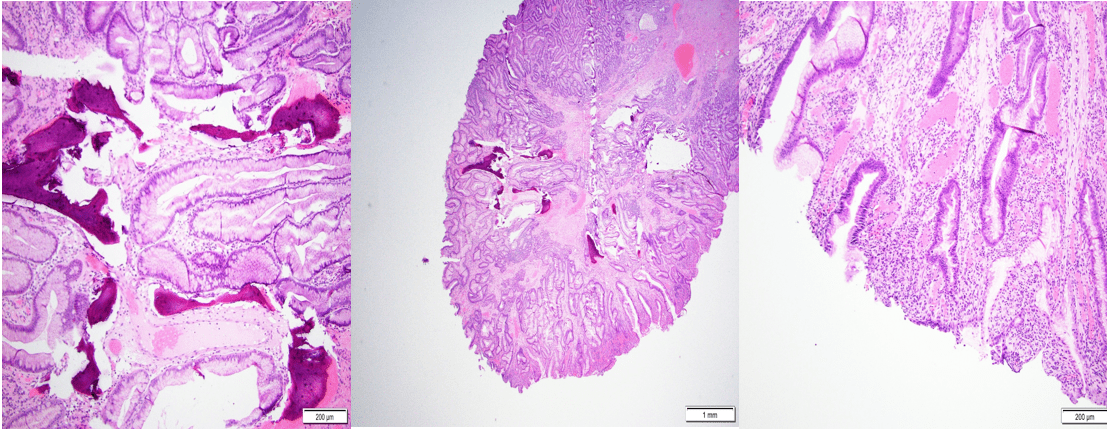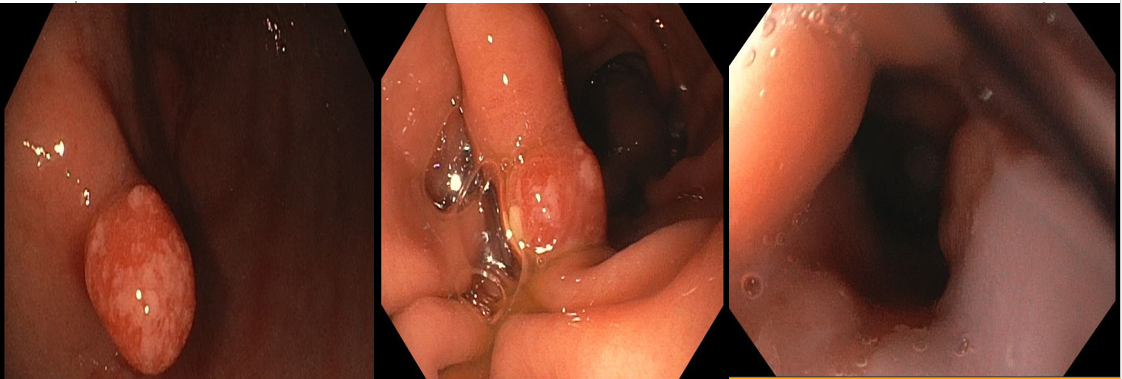Sunday Poster Session
Category: Stomach and Spleen
P2081 - Bones in the Belly: A Case of Osseous Metaplasia in the Stomach
Sunday, October 26, 2025
3:30 PM - 7:00 PM PDT
Location: Exhibit Hall
- GD
Gurtej Dhaliwal, MBBS
Arnot Ogden Medical Center
Elmira, NY
Presenting Author(s)
Gurtej Dhaliwal, MBBS1, Sheel H. Clerk, DO, MPH1, Jose Russe-Russe, MD1, Brendan Gregg, DO1, Tenzin Tseky, DO1, Brian Sowka, DO1, Prashant Jadav, DO1, Daniel Casas, DO1, Thaddeus Sullivan, DO2, Varun Mehta, MD1, Yan Xia, MD1, Gary Valvano, DO1, Bruno Mazza, MD1
1Arnot Ogden Medical Center, Elmira, NY; 2Arnot Ogden Medical Center, Clinton, NY
Introduction: Osseous metaplasia, a rare histologic phenomenon within the gastrointestinal tract, is predominantly described in colorectal lesions. Reports estimate fewer than five cases among 2,000 colorectal cancers, making gastric involvement scarce. The proposed mechanism involves chronic inflammation triggering mesenchymal cell differentiation into osteoblasts via cytokines and bone morphogenic proteins. The following case of osseous metaplasia was identified within a gastric hyperplastic polyp in a patient with chronic negative-H. pylori gastritis.
Case Description/
Methods: A 46-year-old woman with a history of GERD, chronic RUQ pain, PCOS, thyroid disease, obesity, fatty liver, and gastric polyps reported persistent abdominal discomfort. Abdominal imaging showed mild hepatomegaly and steatosis, otherwise unremarkable. However, upper GI series revealed an irregularity in the gastric fundus. Furthermore, during endoscopy, the anomaly was further described as severe antral gastritis (Fig 1C) with presence of multiple polyps; two inflammatory polyps of 0.4 cm (Fig 1B) and 1.2 cm (Fig 1A). Histology revealed foveolar hyperplasia (Fig 2B), erosion (Fig 2C), and osseous metaplasia (Fig 2A), within a hyperplastic polyp; H. pylori negative. She was started on vonoprazan and sucralfate due to PPI intolerance.
Discussion: Gastric hyperplastic polyps are often incidental and benign but merit removal when exceeding 1 cm due to potential for neoplastic transformation. The presence of osseous metaplasia adds diagnostic complexity. Though benign, osseous metaplasia is considered a reactive process linked to long-term mucosal injury, inflammation, or ischemia. In the absence of H. pylori or surgery, chronic gastritis may still trigger this rare stromal transformation.
Osseous metaplasia has predominantly been reported in males and colorectal sites, making this case—female, gastric, H. pylori-negative—highly atypical. While no immediate malignant risk is associated, its presence may reflect disordered tissue repair and warrants close monitoring. This case reinforces the need to biopsy and histologically assess all polyps > 1 cm, even when endoscopically benign. More broadly, it raises the possibility that chronic inflammation alone may drive metaplastic processes, urging clinicians to lower thresholds for intervention and consider histologic changes as markers of underlying mucosal instability.

Figure: Figure 1: Macroscopic demonstration of a gastric polyp 1.2 cm (A), 0.4 cm (B), and severe antral gastritis (C).

Figure: Figure 2: Microscopic demonstration of osseous metaplasia of gastric polyp (A), foveolar hyperplasia (B), and surface erosion (C).
Disclosures:
Gurtej Dhaliwal indicated no relevant financial relationships.
Sheel Clerk indicated no relevant financial relationships.
Jose Russe-Russe indicated no relevant financial relationships.
Brendan Gregg indicated no relevant financial relationships.
Tenzin Tseky indicated no relevant financial relationships.
Brian Sowka indicated no relevant financial relationships.
Prashant Jadav indicated no relevant financial relationships.
Daniel Casas indicated no relevant financial relationships.
Thaddeus Sullivan indicated no relevant financial relationships.
Varun Mehta indicated no relevant financial relationships.
Yan Xia indicated no relevant financial relationships.
Gary Valvano indicated no relevant financial relationships.
Bruno Mazza indicated no relevant financial relationships.
Gurtej Dhaliwal, MBBS1, Sheel H. Clerk, DO, MPH1, Jose Russe-Russe, MD1, Brendan Gregg, DO1, Tenzin Tseky, DO1, Brian Sowka, DO1, Prashant Jadav, DO1, Daniel Casas, DO1, Thaddeus Sullivan, DO2, Varun Mehta, MD1, Yan Xia, MD1, Gary Valvano, DO1, Bruno Mazza, MD1. P2081 - Bones in the Belly: A Case of Osseous Metaplasia in the Stomach, ACG 2025 Annual Scientific Meeting Abstracts. Phoenix, AZ: American College of Gastroenterology.
1Arnot Ogden Medical Center, Elmira, NY; 2Arnot Ogden Medical Center, Clinton, NY
Introduction: Osseous metaplasia, a rare histologic phenomenon within the gastrointestinal tract, is predominantly described in colorectal lesions. Reports estimate fewer than five cases among 2,000 colorectal cancers, making gastric involvement scarce. The proposed mechanism involves chronic inflammation triggering mesenchymal cell differentiation into osteoblasts via cytokines and bone morphogenic proteins. The following case of osseous metaplasia was identified within a gastric hyperplastic polyp in a patient with chronic negative-H. pylori gastritis.
Case Description/
Methods: A 46-year-old woman with a history of GERD, chronic RUQ pain, PCOS, thyroid disease, obesity, fatty liver, and gastric polyps reported persistent abdominal discomfort. Abdominal imaging showed mild hepatomegaly and steatosis, otherwise unremarkable. However, upper GI series revealed an irregularity in the gastric fundus. Furthermore, during endoscopy, the anomaly was further described as severe antral gastritis (Fig 1C) with presence of multiple polyps; two inflammatory polyps of 0.4 cm (Fig 1B) and 1.2 cm (Fig 1A). Histology revealed foveolar hyperplasia (Fig 2B), erosion (Fig 2C), and osseous metaplasia (Fig 2A), within a hyperplastic polyp; H. pylori negative. She was started on vonoprazan and sucralfate due to PPI intolerance.
Discussion: Gastric hyperplastic polyps are often incidental and benign but merit removal when exceeding 1 cm due to potential for neoplastic transformation. The presence of osseous metaplasia adds diagnostic complexity. Though benign, osseous metaplasia is considered a reactive process linked to long-term mucosal injury, inflammation, or ischemia. In the absence of H. pylori or surgery, chronic gastritis may still trigger this rare stromal transformation.
Osseous metaplasia has predominantly been reported in males and colorectal sites, making this case—female, gastric, H. pylori-negative—highly atypical. While no immediate malignant risk is associated, its presence may reflect disordered tissue repair and warrants close monitoring. This case reinforces the need to biopsy and histologically assess all polyps > 1 cm, even when endoscopically benign. More broadly, it raises the possibility that chronic inflammation alone may drive metaplastic processes, urging clinicians to lower thresholds for intervention and consider histologic changes as markers of underlying mucosal instability.

Figure: Figure 1: Macroscopic demonstration of a gastric polyp 1.2 cm (A), 0.4 cm (B), and severe antral gastritis (C).

Figure: Figure 2: Microscopic demonstration of osseous metaplasia of gastric polyp (A), foveolar hyperplasia (B), and surface erosion (C).
Disclosures:
Gurtej Dhaliwal indicated no relevant financial relationships.
Sheel Clerk indicated no relevant financial relationships.
Jose Russe-Russe indicated no relevant financial relationships.
Brendan Gregg indicated no relevant financial relationships.
Tenzin Tseky indicated no relevant financial relationships.
Brian Sowka indicated no relevant financial relationships.
Prashant Jadav indicated no relevant financial relationships.
Daniel Casas indicated no relevant financial relationships.
Thaddeus Sullivan indicated no relevant financial relationships.
Varun Mehta indicated no relevant financial relationships.
Yan Xia indicated no relevant financial relationships.
Gary Valvano indicated no relevant financial relationships.
Bruno Mazza indicated no relevant financial relationships.
Gurtej Dhaliwal, MBBS1, Sheel H. Clerk, DO, MPH1, Jose Russe-Russe, MD1, Brendan Gregg, DO1, Tenzin Tseky, DO1, Brian Sowka, DO1, Prashant Jadav, DO1, Daniel Casas, DO1, Thaddeus Sullivan, DO2, Varun Mehta, MD1, Yan Xia, MD1, Gary Valvano, DO1, Bruno Mazza, MD1. P2081 - Bones in the Belly: A Case of Osseous Metaplasia in the Stomach, ACG 2025 Annual Scientific Meeting Abstracts. Phoenix, AZ: American College of Gastroenterology.
